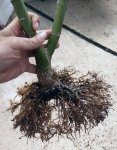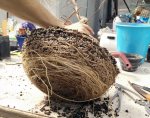I think it's like branch development... you get rid of what you don't need early and build what you save from the grounds up.
It went through harder root work last year and filled up the colander in no time.
Any way it will be a small tree.
Shay
I mean, sure, I get what OP was going for here. I just think there's diminishing returns given that the cleaned up root ball was at a decent starting point for the season, given what needs to happen next for development.
I guess I have a bit of a different philosophy on that. I grow a lot of stuff from early stages, and I've been experimenting with much more gradual cut backs followed by decently long periods of growth. For example, I may target a branch that has to go, but I may not actually remove it for 2-3 seasons sometimes, depending on whether or not I think it can still have some positive effect on the overall system or the final trunk. But if it's already served it's purpose and is about to out-grow the design, then off it goes. You can always shorten branches to slow them down without having to remove them. The main thing it requires is patience.
This is, in my opinion, why we see so many people's trees that show very slow development over 5-10 year periods. They're over-worked. I've definitely tried both ways, and I find I get much better, much faster results by not taking things back to such bare bones so eagerly. Or at least, if I were to do something like the root work in this post, I wouldn't touch that tree's roots in any significant way for probably 4-5 years.
I'm a big proponent of
@Walter Pall 's hedge pruning method, and have been experimenting with variations on that theme for years. In my opinion, the same thing applies to the roots. I tend to let a lot of my trees grow out in nursery pots first. Usually for several years running, the only root work I'll do each season is to lift the root ball out of the pot, gently comb out the perimeter, and trim it up, but still leave only an inch or two of space between the root ball and the pot. Nothing particularly drastic, but gradually cleaning things up, removing old soil, etc. Then I fill it back in with bonsai soil and wait another year. After a few years of this, you have a nice, dense root ball that can be cut WAY back to get it into a training pot.
In fact, I'm at that stage with a bunch of my trees now. I have some large flat training pots that are going to serve as intermediate steps between the nursery pots and bonsai pots. When I finally take the root ball down to fit in the training pot is when I start to do more substantial cut-backs on the roots. I find by treating my trees in this way, they're getting the chance to fully, functionally operate as a miniature tree, at the scale I'm holding them at. I do something similar on top, and I end up with nice, full canopies in fairly short periods of time.
There's always more than one way to skin a cat, and I appreciate that lots of different things work, so I'm not saying my way is definitely better, but I can tell you from my experience that OP's tree probably would have developed just fine without such drastic root pruning, and many of the roots trimmed off may have contributed to future nebari. As this tree thickens up, the roots that are left behind will thicken up, and some will undoubtedly become too big and need to be removed. As it stands now, there's nothing to cut back to that will take over. For that reason alone, the root's in the first pic would have been my last photo before potting it, not my first. =)






